The 46th Special Forces Company — Part I
By SGM John Martin
Originally published in the September 2014 Sentinel
Viet War Delays SEATO Games
BANGKOK (UPI) — A planned Southeast Asia Treaty Organization land-war exercise or 10,000 troops of the eight-nation alliance has been postponed because of the heavy U.S. troop commitment in Vietnam. According to reliable sources quoted by the Bangkok Post Sunday, the war games, which were to have begun in early 1966, were postponed indefinitely. Stars and Stripes, Pacific, February 1, 1966
The other day while I was recovering from knee surgery, I was trying to keep myself occupied by digitizing a portion of many boxes of pictures, negatives and slides that I had taken during my 28 years of service in US Army Special Forces (SF) between 1964 and 1992. One photo, however, brought me back to the heat, odor, sights and sounds of that moment the picture was taken in December, 1966.
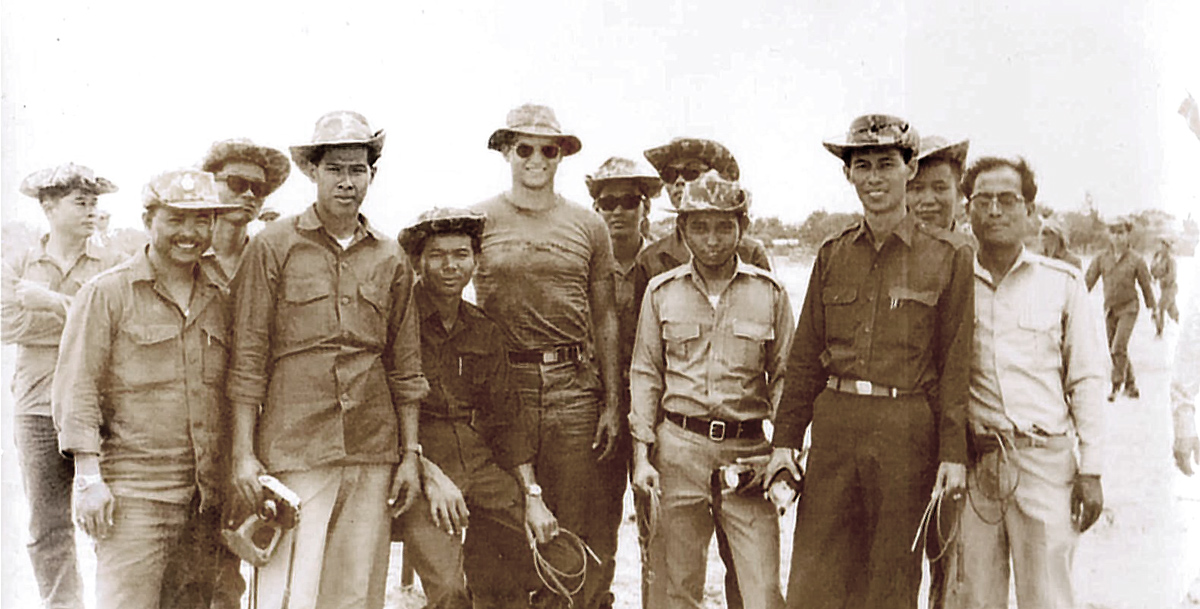
SSG John Martin, Co. D, 1st SFGA, with students of the Thai Railway Police Division who are learning basic and advanced demolition techniques and counter-sabotage tactics to better enable them to counter recent Communist insurgent activity. Photo by SGM John Martin (USA SF, Ret.)
I was a member of a specialized team of seven men that included four SF Demolition Sergeants (SFC Wayne Bute, SSG Wally Gumbs, SSG Philip Devlin and myself), a Medic (SGT James Martin), an Intelligence Sergeant and NCOIC (SFC Donald Tannenbaum), and a Team Leader (CPT Howard Haynes). The students were from the Thai Police Railway Division of the Thai National Police, and the team’s charter was to teach these officers a course in sabotage and counter-sabotage techniques. I felt very lucky to have been chosen for this team because I got to teach every demolition technique in the book and a few things not in any books at the time. Every day I went to work in the classroom or on the range I was enthusiastic as I’d ever been. Here I was in the middle of the ancient Kingdom of Siam with quite a lot of mines, explosives and a recently constructed 100 yards of railway built on our range. It was amazing! Who has such great luck?
As I gazed at the photos from that time, I began to ask myself in reverie, how did I get there? Why was the 46th Special Forces Company (Airborne) (46th SFCA) in Thailand? What were we all doing in this theater of the Vietnam War?
Most of the Special Forces community knows the 46th SFCA spent all of its time in Thailand. Few people knew that Thailand wasn’t where the company’s command and staff told us we were going when we were conducting pre-mission training at Fort Bragg in the balmy days of the Summer of 1966. I also realize that not too many of the Special Forces community today and even fewer others really know how and why the 46th Special Forces Company came into being, what it was supposed to do when it deployed to Southeast Asia, and what came to pass when the unit was finally deployed to Thailand.
I would like to provide a little more clarity from the eyes of an early and repetitive participant of some of the more unknown 46th SFCA activities that contributed indirectly to the Vietnam War effort and more directly to the “Unseen War” in Laos. My observations were taken during a total of 42 months assigned to the 46th SFCA. The time was distributed over three separate tours, the first tour of 18 months and two successive tours of 12 months each. Each of the 12-month tours in Thailand was preceded by a 12-month tour in the 5th SFGA in Vietnam. Literally, I bounced back and forth between Thailand and Vietnam from October, 1966 to January, 1973 with a brief 10-month tour in the 1st SFGA on Okinawa in the mix. I decided to write this article as a casual observer to events that would help explain the evolution of a unique Special Forces organization during the Vietnam War.
In the Beginning
“On the Plain of Jars, the Pathet Lao advance gradually slowed due to the destruction of its supplies by airpower, and Laotian troops then counter-attacked. By August 1966, they had advanced to within 45 miles of the DRV border. North Vietnam then sent thousands of its regular troops into the battle and once again the Laotians were forced to retreat.” (Pribbenow, p. 218)
In the Spring of 1966 I was living in the barracks at Fort Bragg, North Carolina – a “barracks rat”. I was just a SP4 in C Co., 7th SFGA on Smoke Bomb Hill. Since graduating from SFQC as a fledgling Special Forces Demolitions Specialist, I’d been living in the barracks and pulling my share of company and post level details ranging from picking up pine cones and painting rocks to pulling ammo dump guard and fireman duty. In those days, heat and hot water for the barracks was from coal burning stoves, so stoking the furnace at night and watching out for fires was a necessary but just one of the unglamorous duties for those of us who lived in the barracks.
For self-entertainment I took up skydiving on weekends at the Green Beret Sports Parachute Club and occasionally cruised the bars in downtown Fayetteville on Hayes Street. I wasn’t on orders for Vietnam yet, so I was low hanging fruit when they started looking for men to fill the lower echelon ranks of what at the time was designated as D Company (Augmented), 1st Special Forces Group.
I joined D Company at Fort Bragg, NC in April, 1966 and was assigned to an A-Team, A-413, formed under the firstly formed B-Team, B-410. I couldn’t have been more excited. My quest for duty as an SF trooper in the war against Communism in Southeast Asia was actually going to happen. The best part for me and my fellow barracks rats was we were excused from post support details. No more painting rocks and picking up pine cones! It was all even more intriguing because of the hush-hush nature of where we were supposed to be deployed and what our mission was. I felt like I was a part of something really special. I was certainly ordinary, but the history of the 46th Company is special.
The rest of the 1st SFGA HQ and A, B, and C companies were stationed on Okinawa. The Group’s area of interest was all of Southeast Asia. The 1st Group’s missions included supporting the 5th SFGA (Vietnam) with temporary duty (TDY) teams from Okinawa. In addition, the 1st SFGA had permanent resident teams in Korea, Taiwan and the Philippine Islands as well as TDY teams in Thailand and teams supporting the CIA’s top secret operations in Laos.
The most notable effort SF participated in Laos was Project White Star (1960-1962). Agency and SF operatives recruited and trained Laotian ethnic minority tribes to counter North Vietnam’s incursions into Laos and their support to the Communist Pathet Lao forces, but because of the weak tripartite government (Royalists, Neutralists and Pathet Lao) of Laos and its declared neutrality, US support had to be kept at a very low level of visibility from the public eye.
Vacillating US and Laotian politics caused Special Forces to end their support of project White Star in 1962; however, Agency operations and support to the Royalist forces continued without them. Although the CIA support of the Royalist forces had a mixed record of wins and losses, by late 1966 Pathet Lao and NVA forces had retaken the Plain de Jars and had established a relatively secure network of supply routes to South Vietnam along its border with Laos and Cambodia.
The 46th Special Forces Company Is Formed
“The Special Guerrilla Unit project…was probably unique in the history of warfare. Here was a large nation—the U.S.—hiring soldiers of a small nation—Laos—to fight primarily for the objectives of the large nation on the territory of the small nation against an invader—North Vietnam—on behalf of another small nation—South Vietnam.” (Sananikone, 1981)
Company D (Augmented), 1st SFGA was activated by CONARC General Order #34 on April 15, 1966. A total of 369 officers and men were assigned, and I by luck and circumstance was one of the early picks. Within days of the company’s activation, I was assigned to team A-413. I thought being picked for D Company, 1st SFGA was a dart board exercise, but I learned that team sergeants were able to hand pick their team from all “available” NCOs at Fort Bragg. “Eligible personnel” meant those who were not currently on orders for Vietnam or those who had been back from Vietnam for more than six months. As I said, not being on orders for Vietnam put me floating on top of the “available” pot. I was fortunate that my Company Sergeant Major, SGM Dick Shevchenko, was picked for the initial 46th SFGA formation as well as one of my company’s team sergeants, Gerald “Moose” Brannon, a veteran Ranger in WWII, Korea and Vietnam. Having worked with these outstanding senior NCOs may have the reason for my good fortune at having been recruited so early. And, so it went for the other two B-Teams and their subordinate A-Teams. The B-Team and A-Team slots filled quickly. I can’t remember one person who was chosen that grumbled about being assigned to the 46th Company. It eventually became known as “The Original Good Deal”, a moniker I didn’t appreciate until I was on the ground in Thailand. I just was happy to be going to war finally.

Ho Chi Minh Trail network. Location of the Bolaven Plateau relative to the Ho Chi Minh Trail. (Map U.S. Army with addition of the Bolaven Plateau marking)
Pre-mission Training
“Laos is far from America, but the world is small…the security of all Southeast Asia will be endangered if Laos Loses its neutral independence.” — John F. Kennedy, 23 March 1961
The unit’s mission was tightly held, but once the teams entered the the 46th Special Forces Company Area Studies building it was obvious that our mission was to be the “Western Front” of the Vietnam War. Each team dove into the target folders that had been assembled from CIA and White Star area studies to find the team’s area of operation. My B-Team and its four subordinate A-Teams were to be inserted onto the Bolaven Plateau (Fr., Plateau de Bolaven) in southern Laos. We were to establish fighting camps from which we would train Laotian tribesmen to conduct operations against the Pathet Lao and North Vietnamese Army (NVA) forces. From these camps we would launch interdiction operations westward against the Ho Chi Minh Trail that in the Bolaven area ran along the base of the eastern edge of the Bolaven plateau and into South Vietnam. What a mission to be involved in for a SF rookie like myself! I couldn’t believe I would be part of such a bold move in the war where interdicting the Trail was victory half won.
The remainder of that summer was spent on area studies, language training and rehearsing classes that we would have to present to our new indigenous troops once we got the camps built. Military skills exercises consisted of patrolling and reconnaissance exercises, raid and ambushes, road marches, and quite a few “team building exercises” at the Main NCO Club at the end of the day. Rookies like myself absorbed war stories of the senior NCOs who were perfectly willing to feed us tall tales with a large spoon. At the same time, of course, we rookies were being observed with critical eyes as to how we talked and acted throughout the day as well as when we had our snoot filled with 3.2 beer. The sessions in the NCO Club were just another form of assessment under duress. Maintaining a sense of humor and flexibility in all situations was a chief ingredient to being a team player that could be counted on.
Some of us took a limited fluency Thai language course lasting eight weeks. By the course’s end, the best of us could speak a few rehearsed phrases, but we never got to the reading and writing of the Thai script. For a few learners it was a basic primer that eager minds would improve upon while in country. With a knack for languages, I was able to improve on my conversational ability once I got in country, and I built my conversational skills during subsequent tours. It was a capability that I still have retained although regrettably, most of my discussions these days in Thai are with waitresses and owners of Thai restaurants.
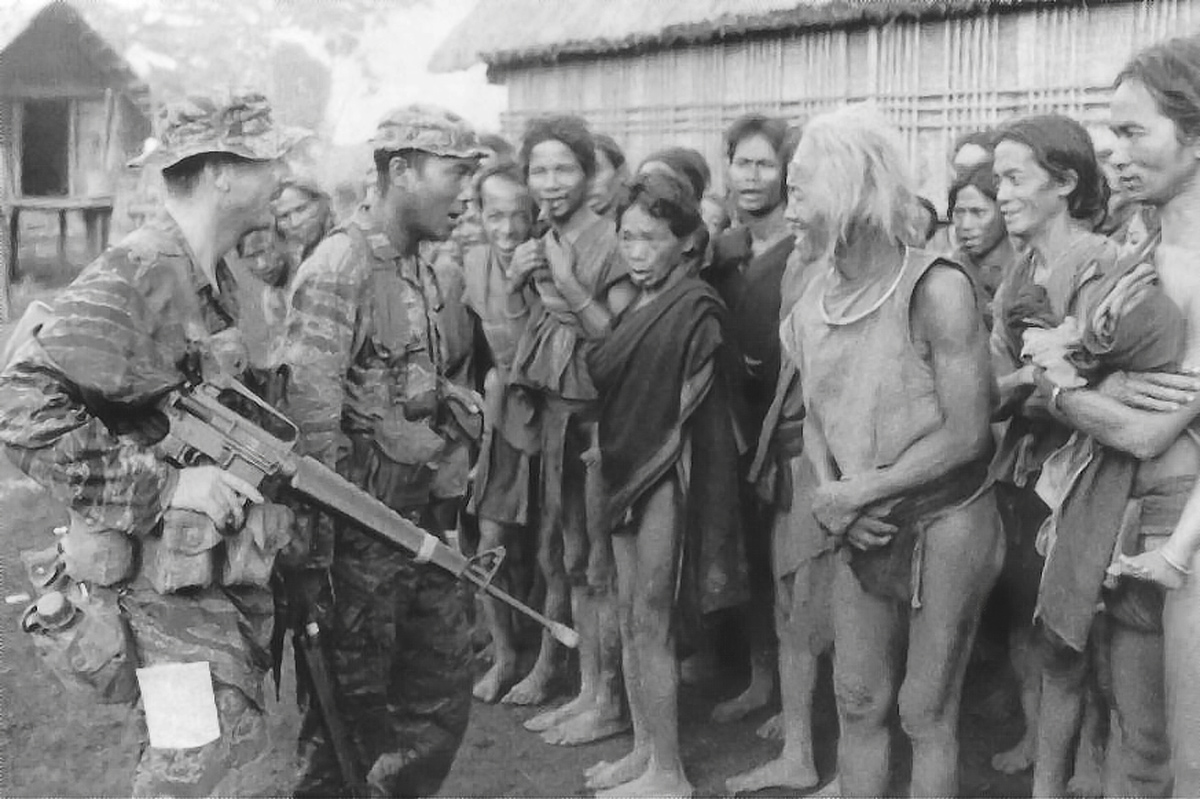
Unidentified USSF soldier talking through an interpreter to Montagnard tribesmen, II Corps Tactical Zone, Vietnam. (Public Domain)
Deployment
By early September, the teams had been formed and trained. There was a hiccup on the deployment date so we were given ample time to take leave. This was especially good for the married men, but we unmarried few couldn’t wait to deploy as soon as possible. Finally, we got the word that our B-Team and four A-Teams would deploy on October 10, 1966.
On deployment day we assembled down on Yellow Ramp of Pope AFB. Team boxes and duffel bags were already palletized and loaded on our awaiting C-141 that would take us all the way to our initial destination – Takli Royal Thai Air Force Base (RTAFB), Thailand. Our flight would first fly to Elmendorf, Alaska for refueling, and then on to Yakota AFB, Japan for another “refueling”. Not many wanted to get off of the plane at Elmendorf because it was so cold and snowy, but we were bused into the terminal where we were served sandwiches and lukewarm coffee. Once the plane was refueled we got out of there as soon as possible. Brrrr. Next stop, Yakota, Japan.
Yakota AFB was kind of a pleasant surprise even though we landed there in the middle of the night. Our acting B-team sergeant major, MSG Marv Compton, had been an NCO club manager at one time, and was known as quite the wheeler dealer. His connections to the club system around the world were legendary. When we landed at Yakota, Marv dashed to the nearest phone and contacted an old acquaintance who ran the Yakota NCO Club. It was already past midnight when we landed, but the club manager released all the unnecessary help and held the club open for us all night. We still had another 12-hour ride to Thailand so everybody looked at this opportunity as a good time to sedate themselves for the next long leg of the journey. It sure beat lukewarm coffee and dry sandwiches. When we crawled to or were carried back onto the plane, everybody found a place to lay down for the long ride to Takli RTAFB—not a creature was stirring for the long flight to Thailand. We were all self-sedated thanks to Marv and his club manager friend.

LTC Roger Pezzelli seeing off B-410 and its four subordinate A-teams at Pope AFB, 10 October 1966. Photo by SGM John Martin (USA SF, Ret.)
For the travel weary and hung over souls onboard, our arrival at Takli was a hot, rude awakening. We expected it to be hot and humid, but since we had been shivering under our poncho liners all the way across the Pacific, Takli was a sauna! When we landed, it must have been at least 90 degrees and near 90 percent humidity. That was no place to spend much time on a cement airstrip. As soon as the engines quit, we wanted out of that plane.
Our arrival also revealed a little discordance between the military and the diplomatic corps. As the ramp went down on the C-141, a couple military officers and a man in civilian clothes rushed up to the airplane and told us not to get off of the plane. Apparently, our little band of merry men didn’t have diplomatic clearance to be in Thailand. Tempers flared while we were sweating like a criminals in a torture chamber inside that aircraft while our military staff and the ambassador’s representatives worked things out. Besides suffering from the heat, we were all worried we were going to have to take off and go to another country. Someone mentioned the crew was planning a tentative route to Okinawa. Bad news!
We were stupefied that we would have flown all the way from Fort Bragg to this Thai Air Force base without the consent of the US-Thai military and diplomatic corps ahead of time. By the time we were melting and near dead with the heat (and hangovers), some strings were pulled, some permissions granted. We finally were allowed to download ourselves and equipment and were driven in large buses for three hours to the Company headquarters in Lop Buri, Thailand.
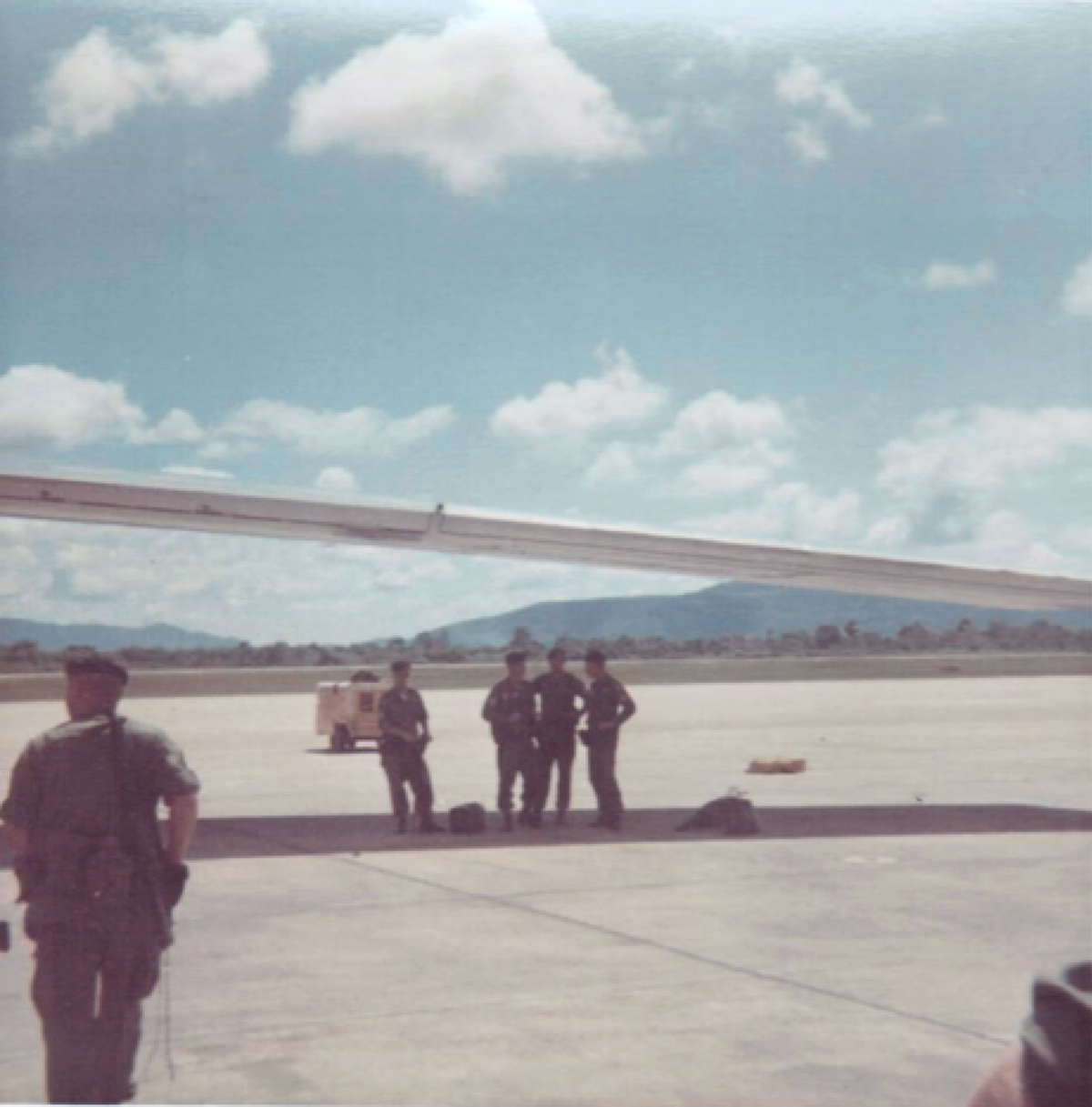
Troops look for relief from the heat at Takli RTAFB, Thailand. Photo by SGM John Martin (USA SF, Ret.)
Change of Plans – Off to Nam Pung Dam
While we sat in our temporary barracks at Camp Pawai in Lop Buri, we had a week to assimilate to our new environment and overcome the effects of jet lag. It was oppressively hot, but we managed to catch the end of the tropical monsoons so we had plenty of humidity to go with it.
Now, I was just a young trooper who barely had clearance to listen to rumors, but whether through a recent diplomatic change or the unravelling of an original cover up plan, I have no idea after all these years why or when our mission changed. One thing was for sure – we weren’t going to Laos. Instead, our B-team and four A-teams would be bused to northeastern Thailand to a high plateau above the small town of Sakon Nakon. The sight picked out was triple canopy jungle overlooking the reservoir lake of Nam Pung Dam. The dam had been built as part of the Japanese war reparations, but there wasn’t a village for miles. Sakon Nakon was 35 bumpy, dusty miles away.
Our days of quick air travel were over for a while. We and our equipment were loaded on Thai buses and driven north, first to Udorn RTAFB on the first night where we were hustled into barracks for the night. The next day we had another long ride to the site where we were to build a camp. By the time we got to Nam Pung Dam after riding two days in seats built for smaller people, we would have been happy to get off the bus outside of Hades. It was nearly impossible to sleep on the bus, and the only air conditioning was open window. Since the second day was mostly on dirt roads, we sure looked a sight when we piled off of those buses. We were caked with a patina of sweat and red laterite road dust.
The next order of business was to lay out the camp in this dense jungle, to clear the land and to construct the camp’s seventeen buildings and numerous field fortifications. On that first night, however, we camped in the jungle with only C-rations and what might be left in our pockets to eat. We were finally at the end of one long road that started at Fort Bragg, NC, but we would journey down many more interesting paths with the 46th SFCA.
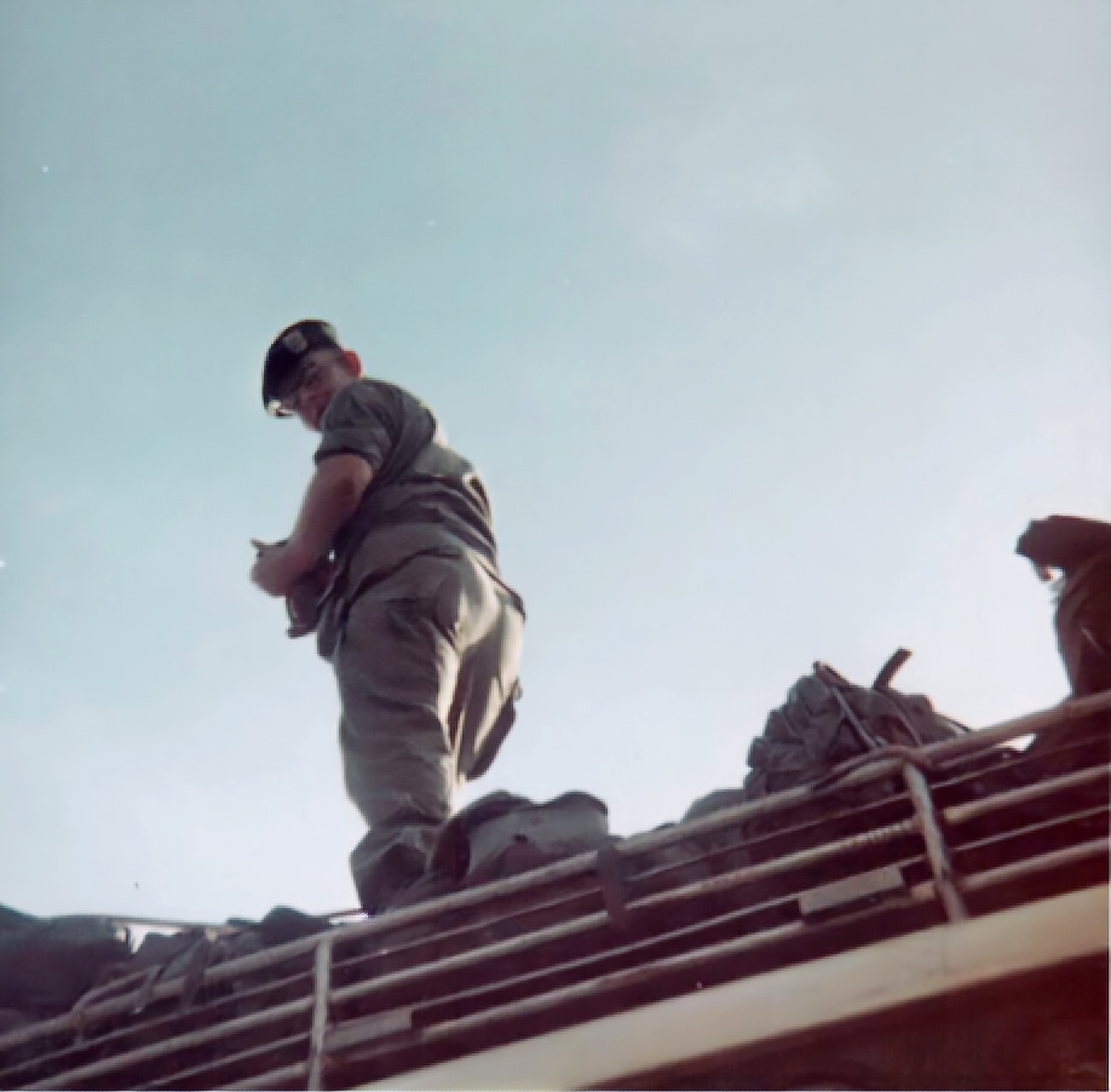
SFC Donald “T-bomb” Tannenbaum (Intel SGT) makes last minute adjustments to our equipment on top of the bus for the two-day ride to Nam Pung Dam.
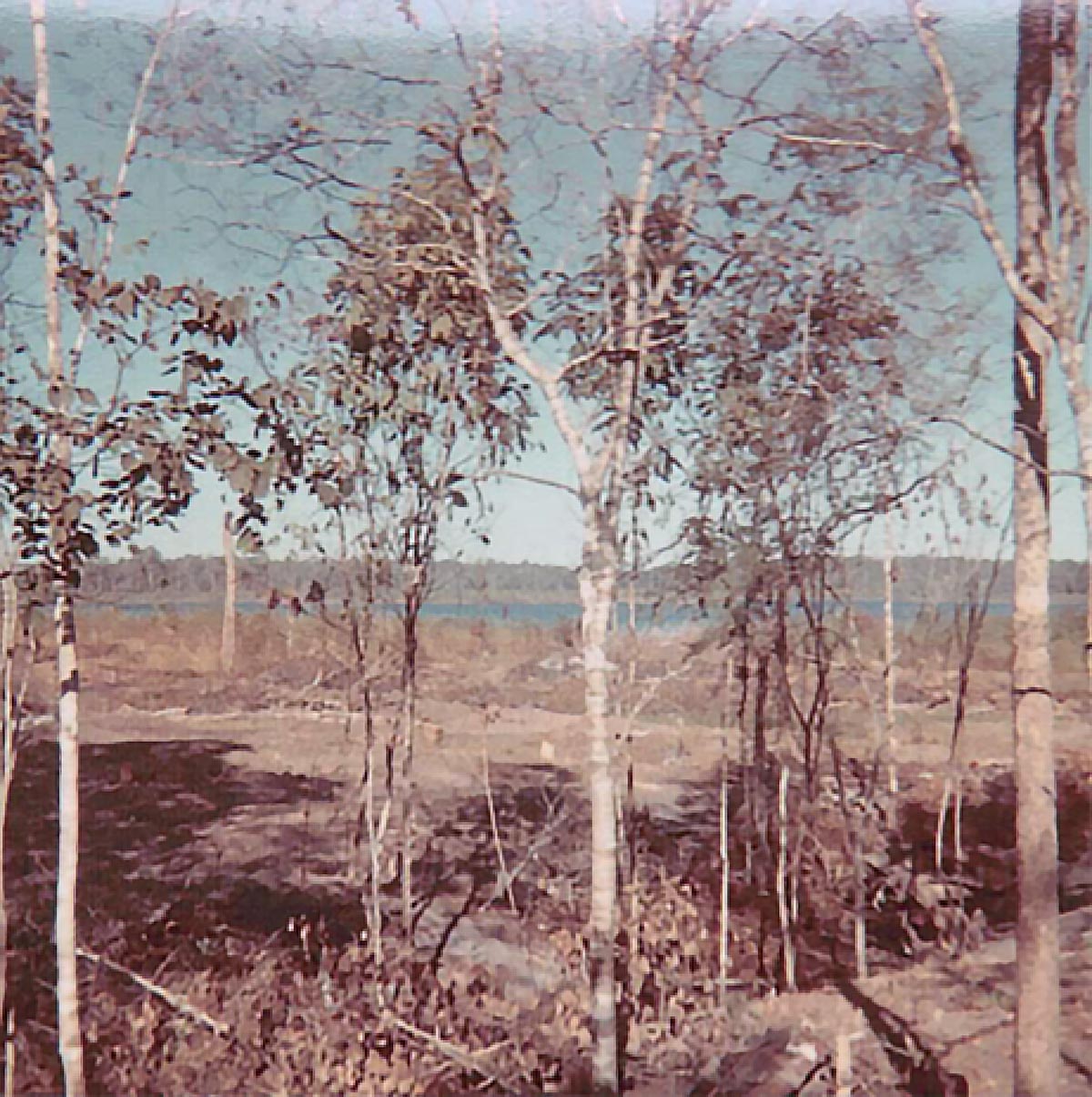
A view of Nam Pung Dam Reservoir viewed from the “front gate” of a yet-to-be-built Camp Hunky.
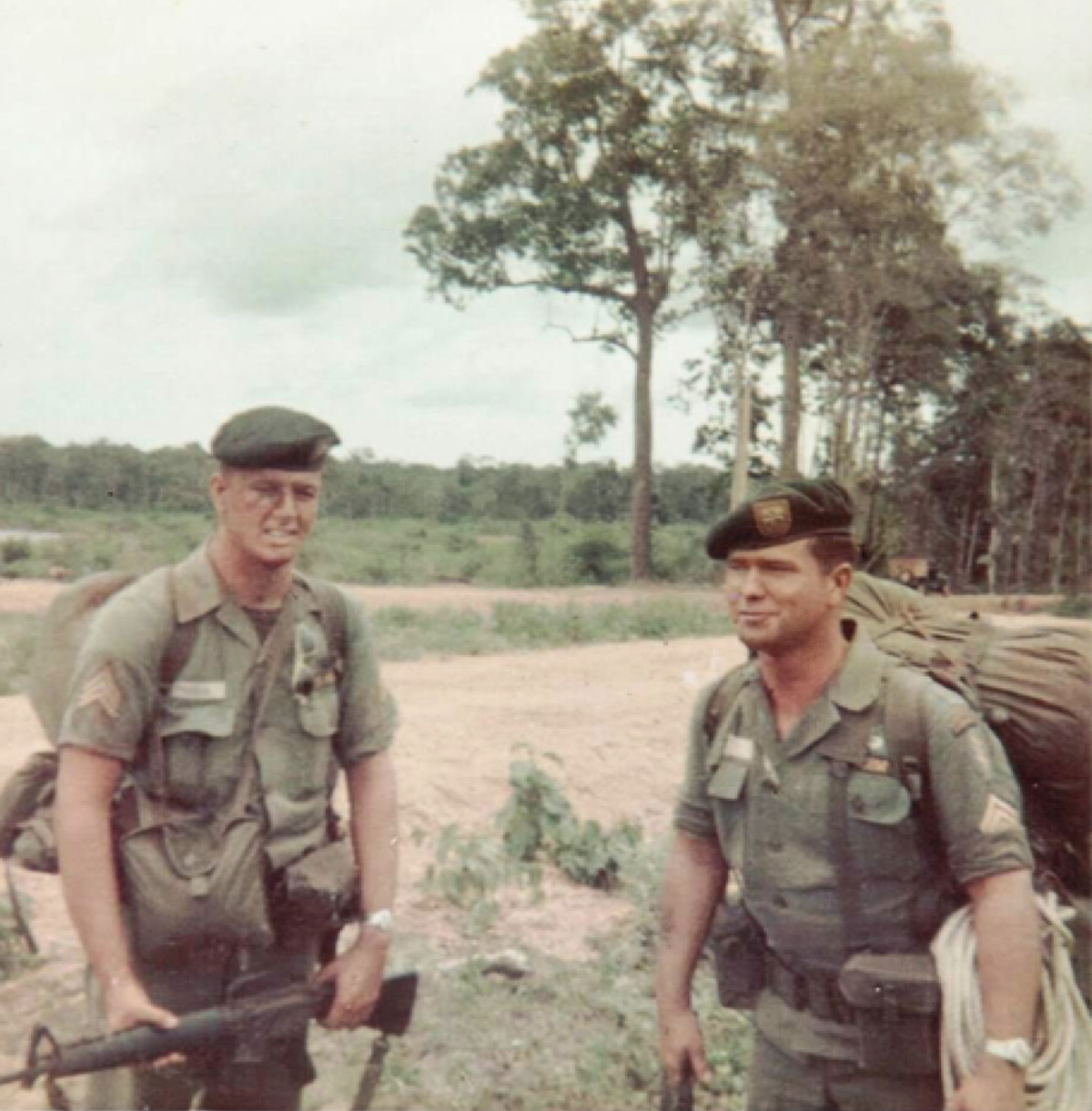
SGT George Psaila (Medic) and SFC Duke Payne (Commo SGT) get off the bus at Nam Pung Dam still wearing road grit from the two-day journey. Photo by SGM John Martin (USA SF, Ret.)
Conclusion
This monologue has detailed the start of my long journey from the United States to Thailand. Nam Pung Dam was not the end of a journey but, rather, the start of other journeys including some of the more bizarre bends in my path from Nam Pung Dam to the Railway Committee.
The reasons why we never deployed into Laos are still obscure to me today, but, hopefully, I will find a more authoritative source that can explain who made the decision and why. In the meantime, I will explain some of the curious events that happened while I worked on teams that supported the training of Laotian Royalists forces in Thailand. Had I not served on those teams, I might not have had the deeper knowledge of what was transpiring in Laos in 1966 when our mission changed so abruptly. Let’s just say that from hearsay evidence I have gleaned, North Vietnamese territorial conquests where we hoped to establish our own camps made our employment into Laos “infeasible.”
As to what we were doing in the theater of the war in Southeast Asia, let me just say that we were in direct support to the military mission in Laos but not to the degree that we would have liked. We wanted to be in Laos and support from there, but the military brass and the diplomats would not even consider it. Laos and Cambodia were declared neutral states. Sending in the military overtly or covertly was just not in the cards for the U.S. Worse yet, our efforts did not change the course of events unfolding in the two Vietnams over the next nine years to its end in 1975. The fall of Saigon in 1975 was inevitable given the fact that the North had almost unfettered use of the Ho Chi Minh Trail. Had we “pinched” it from the West with effective interdiction, who knows what might have changed what is now history?
Despite the negative aspects of what transpired, I will never forget the men I served with, whether Thai, Laotian or American, whether soldiers, diplomats or government agency operatives. We were all in it together. I’ll be thumbing through old photos of those years of fond memories and rewarding times for a young soldier who answered his nation’s call.
This is the end of part 1 of a 4-part monologue.
Part 2 will explain the hilarity of building an SF fight camp with 72 nail bending amateur carpenters, the dry well, discoveries of foliage and fauna hidden by the jungle covering the camp site, and, finally, the inaugural opening of Camp Hunky. It will also cover my assignment to the Railway Committee and its development into a counterterrorism program of instruction at the Thai National Police Training Academy, Korat, Thailand.
Part 3 will concern itself with my second tour and my assignment to A-11 at the Thai Infantry Center, Pran Buri, Thailand where we ran a program of instruction for reconnaissance companies for Laotian SGUs. This was a project that was supervised by COL Lewis L. “Bayonet” Millet (CMH).
Part 4 will cover my third tour and my assignment to another Agency project where we trained heavy weapons battalions at Ban Nong Seang on the Thai-Lao border east of Ubon RTAFB.
References
John F. Kennedy: “The President’s News Conference,” March 23, 1961. Online by Gerhard Peters and John T. Woolley, The American Presidency Project
Sananikone, O. (1981). Royal Lao Army and U.S. Army Advice and Support (p. 140). U.S. Army Center of Military History.
Victory in Vietnam: The official history of the people’s army of Vietnam, 1954–1975, The Military History Institute of Vietnam (p. 218). (2002). Lawrence, Kan.: University Press of Kansas.
“Viet War Delays SEATO Games,” (1966, February 1). Pacific Stars and Stripes, p. 3.
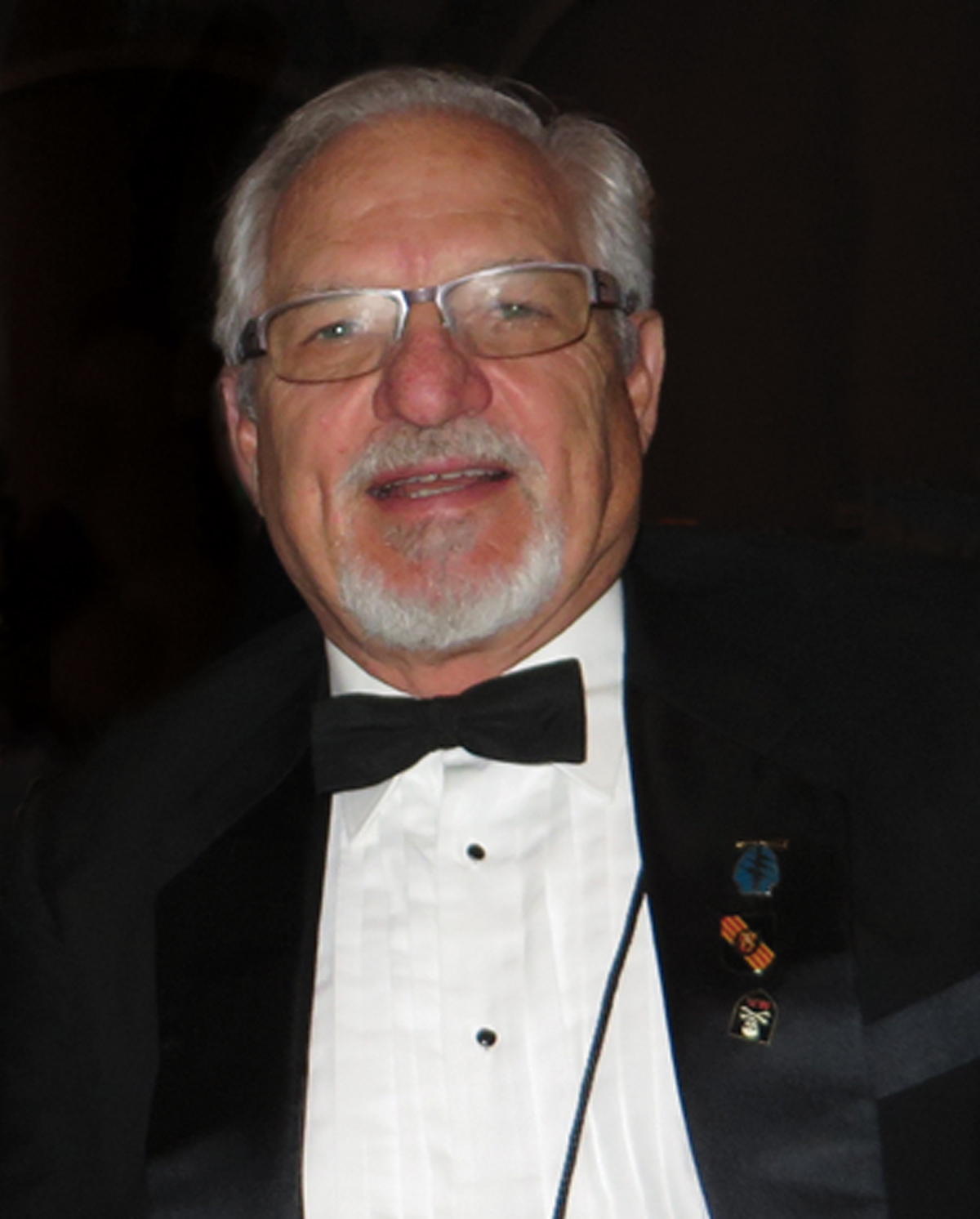
ABOUT THE AUTHOR — SGM John Martin retired from the United States Army Special Forces serving over 28 years in the Special Operations Community. John served three tours in Thailand and two tours in the Republic of Vietnam, Okinawa, Korea, and had extensive host nation training missions in Egypt, Sudan, Jordan, Iraq, and Kuwait. Since his retirement from the 1st SFOD-Delta in 1992, he has worked extensively with the Department of Homeland Security and the National Guard Bureau in Washington, DC in the field of Critical Infrastructure Protection. He has a BA and MA and is an instructor at the Northern Arizona University teaching Critical Reading and Writing in the Honors Program.
I want to thank SGM John Martin for Part 1, the creation of 46th Company, Special Forces Thailand. In 1972 I was a young Commo man, fresh out of Training Group assigned to Bravo Company, A-33, Nam Phong Camp, Northern Thailand. Our teams missions were to train, advise and support the Hmong Army and Thai Volunteer projects in unconventional and guerrilla warfare training. Part 1 of your story brought back many fond memories of the men I worked with in Group, Sky, Air America and of course the brave indigenous soldiers who fought to liberate the oppressed. Again thanks and looking forward to future parts of your story, DOL
I enjoyed reading this memoir and seeing the names and photos of old friends. Oddly I was using Dick Shevchenkos old mountain ruck this morning carrying some tree cutting gear into the local woods. That ruck was in Laos for Hot Foot before ending up in with me in Lopburi.
I was in C Company of the 7th same time as Martin. I have a picture of Martin in Pisgah during a FTX.
I love this type of down to earth history from former operators. I’m looking forward to reading the next chapters. Thank you for sharing.
Damn I loved reading everything about 46 special forces so thank you so much SGM John Martin for taking me on a ride with you and your team! I almost felt as if I was there with you! They should make a movie ,so that we could see what it was like back in 1966 and what the 46 th special forces mission was like and what it really meant and why!. My step dad was SGT major Moose Brannon and I was looking him up to find out more about his life as a soldier! I would love to know more and if I had the money I would want to make a film about 46 th Special Forces operation! I have reel to reel of him and some of his buddies in my basement but I have never listened to them! My quest.is to get a reel to reel so that I could go back in time and and feel the air change and listen ! Alot of laughing and a lot of drinking back then ,I’m assuming ! but after reading this , it is on my to do list asap to buy an old reel to reel so I can experience how they felt and listen as if I’m there with them as well! Thank you for your time to have written everything and I can’t wait to hear more! Thank you for your service ,and can you tell me more stories of Moose Brannon? Thank you if you can!